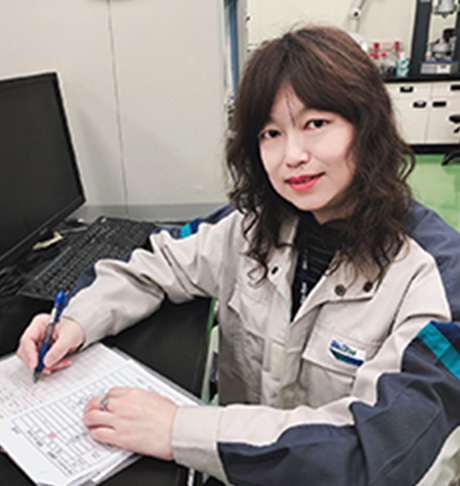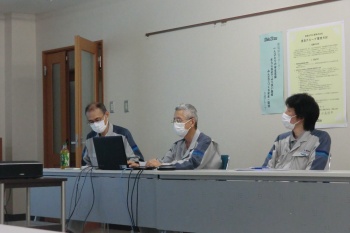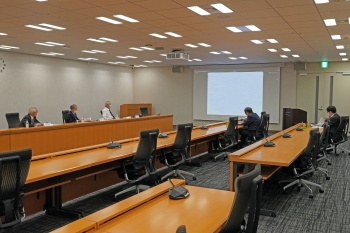Product Quality Improvements and Product Safety Control
Policy
The Group will stably supply high-quality products to customers.
Awareness of Issues
The Group is working to achieve "Claim Zero." The superior quality of general-purpose products as well as high-value-added products will lead to non-price competitiveness. In order to ensure a stable supply of products, it is essential for the sales, R&D, production, quality assurance, and shipment departments to fulfill their respective roles. In addition to product characteristics, environmental and health safety are also important factors for product quality.
Quality Control
The Group focuses on stably supplying the high-quality products that customers demand. In quality control, we are committed to "defensive quality control" that does not produce or ship irregular products, and "aggressive quality control" that minimizes variations in quality and creates quality that cannot be followed by other companies. We have established a robust internal quality management system and are continuously working to improve quality and reduce deviations and waste.
In each of our business divisions and group companies, Sales Department, R&D Department, Production Department, and Quality Assurance Department cooperate in the following roles to respond customer requests.
Sales Department
Understands the customer's requests, and promptly and accurately share the information with our R&D Department and Production Departments.
Research and Development Department and Production Department
Research and develop new products and improve existing products based on the customer's requests.
Also promote the automation of the manufacturing process to achieve consistent quality.
Quality Assurance Department
Makes the final quality confirmation on the product while taking into account product characteristics and customer usage.
Enhances the accuracy of quality measurement by pursuing the automation of measurement processes to eliminate variations due to quality measurement personnel, sample preparation, and measurement procedures.
In addition, converts measurement results into data and used to prevent typing errors when creating inspection tables and labels.
Almost all of the Group's manufacturing bases, both domestic and overseas, have obtained certifications for their quality control systems, such as ISO 9001. Furthermore, some Shin-Etsu Chemical plants and group companies have acquired quality management system certifications such as IATF16949.1 We have also established a strict rule to respond to all inquiries of product quality from customers within two business days.
- 1 IATF16949
A quality management system for the automotive industry
Related Information
Employee Initiatives

Ms. ZP,
Quality Assurance Department,
Shin-Etsu Silicones Taiwan (Taiwan)
1.Please tell us about your current responsibilities.
Currently, as the manager of the Quality Assurance Department, I am in charge of ensuring product quality, inspecting manufacturing processes, responding to complaints, calibrating and managing measuring equipment, and certifying and educating inspectors.
2.Please tell us about the product safety management efforts of the Quality Assurance Department.
Our plant manages product safety in accordance with the ISO9001 quality management system. Specifically, we conduct acceptance inspections of raw materials, make acceptance judgments and put a note of chemical substances information on it. We also provide regular maintenance of inspection and measurement equipment and help implement changes in product design. In addition, we conduct quarterly internal quality audits to supervise corrective and preventive measures and confirm the effectiveness of corrective actions.
3.How does the Quality Assurance Department work with the sales, R&D, and production departments?
We work together in the following roles to meet the needs of our customers.
・Sales Department
Preparation of product specifications, preparation of COA1, QC2 process chart and complaint report, explanation of product shelf life and storage conditions, preparation of complaint report, provision of process change notice to customer, answering to customer audit questionnaire and inspection questions.
・R&D Department
Execution of product design changes, pre- and post-trial discussions, development of new product specifications, chemical analysis of customer complaints.
・Production Department
Inspection and judgment of intermediates and products, support for quality education and training of employees and managers, conducting quarterly internal quality audits, investigating the causes of customer complaints, tracking corrective and preventive actions, organizing quality improvement meetings, correction of process abnormalities and preventive measures and confirmation of effects after correction.
4.How do your company control and ensure product safety?
The person in charge at the Director's Office of the Technology Center prepares and issues SDSs to ensure the safety of our products. In addition, as a safety measure for product transportation, we ensure that products are filled and packaged according to packaging specifications, and that accidents during transportation from manufacturing to shipping do not affect the quality or environmental safety of the product containers and appearance. Dangerous goods are marked with UN number, dangerous goods classification, pictogram classification, etc. according to UN standards. Furthermore, we provide our customers with product specifications, COA, and QC process charts, and explain the shelf life and storage conditions.
5.What do you want to focus on in terms of product quality and safety management in the future?
(1)In order to deliver accurate data to our customers, automatically import inspection data for each item from the quality assurance department into the shipping report system.
(2)Implementation of training according to standard procedures for inspectors in the quality assurance department.
(3)Confirmation and follow-up of improvements to issues pointed out in internal quality audits of each department.
(4)Prevention of contamination of products with foreign substances and management of products that do not contain harmful substances.
Focusing on the four items above, we will continue to focus on stably supplying the high-quality products that our customers demand.
- 1COA(Certificate of Analysis): A legal document created to ensure that a product meets the specifications printed on its label. Assurance to the customer that the manufacturer has duly considered its product and completed the necessary quality control processes.
- 2QC(Quality Control Chart): Management characteristics and methods are described for each process from the arrival of raw materials to product shipment.
Quality Audits and Support
Since 2000, we have conducted quality audits annually to improve quality and customer service.
Quality audit evaluates quality from two different viewpoints: customer and quality cost. Through this, we work to identify the root cause of quality issues to prevent re-occurrence.
In the quality audit in FY2022, the following items were audited as priority items:
- (1) "Efforts to reduce variations in manufacturing processes":
In addition to improving the conventional manufacturing variations, we confirmed the improvement status of quality through the introduction of DX and AI. - (2) "Automation of inspection process":
We are promoting automation of measurement to prevent human errors caused by a person’s misunderstandings and to eliminate measurement variations which are dependent on persons. In this audit, we confirmed the status of improvement in accuracy of quality measurement. - (3) "Promotion of quality improvement activities":
We confirmed the status of quality improvement activities such as "yield improvement" and "careless mistakes," which have been continuously implemented.
Six Sigma programs1 were also deployed throughout the company to improve the quality level.

Quality audit
(September 2022 ,
Shin- Etsu Chemical Kashima Plant)

The 22 nd debrief session of the
results of Shin- Etsu Six Sigma
(February 2023, Shin-Etsu Chemical
Head Office)
- 1 Six Sigma programs
Quality improvement method developed by Motorola in the 1980s. Focusing on processes with quality variation, it is designed to minimize variations within the processes, thereby reducing the incidence of quality defects. This approach has been adopted across the Group.
Product Safety Control
We manage product safety, from product development to transportation, based on internal regulations. We have established regulations for each stage of chemical substance procurement, development, manufacturing, and sales, and strictly manage them. We are actively involved in conducting field surveys related to the manufacture, use, and disposal of chemical substances, and in obtaining data for research, in cooperation with the government and organizations to which we belong. For example, in response to the POPs Convention, PFOS, which is designated as a type of specified chemical substance (prohibited to manufacture and use) under the Chemical Substances Control Law1, is used as a foam fire extinguisher. PFOA was used as a product raw material. Although, both are in the process of being changed to alternative chemistries or have completed the change. In addition, we are investigating the use of substances that are scheduled to be regulated in Japan and overseas, and are taking steps to change them.Furthermore, we are taking measures to comply with the regulations stipulated in the revised Industrial Safety and Health Act to minimize the impact on workers when manufacturing and handling chemical substances. To ensure the safety of new chemical substances, we assess and confirm environmental and health risks at the development stage. When developing new chemical substances, we focus on products and manufacturing technologies that do not use hazardous substances that have been designated by the Industrial Health and Safety Act and Chemical Substances Control Law, as well as the EU RoHS Directive.2 Furthermore, we make sure that the necessary notifications and reports are submitted according to laws and regulations.
We offer customers information such as on product hazards and harms in the form of SDS3 in order to ensure the proper transmission of information to customers and transportation f irms. In addition, we request customers to handle products safely by complying with laws and regulations, installing abatement equipment, wearing protective equipment and so on through SDS.
As a product transportation safety measure, we issue yellow cards4 and container yellow cards5 that are affixed to containers. In accordance with the Industrial Safety and Health Act, we also attached symbols to indicate hazardous and harmful substances in accordance with GHS6 on product containers and packaging.
- 1 Chemical Substances Control Law
Short for "Act on the Evaluation of Chemical Substances and Regulation of Their Manufacture, etc.," it is intended to prevent environmental pollution by chemical substances that can be harmful to human health or to ecosystems. - 2 Restriction of Hazardous Substances (RoHS)
An EU directive that restricts the use of certain hazardous substances in electrical and electronic equipment. - 3 Safety Data Sheet (SDS)
SDS lists the physical and chemical properties of chemical substances, together with their harmfulness and emergency response procedures. Designed to promote safer use of chemical substances and prevent accidents and incidents, SDS are supplied by manufacturers, importers, and distributors to customers during sales or shipment. - 4 Yellow cards
Yellow cards are cards that describe all relevant information on the treatment required in case of an accident during the transportation of chemical substances. The cards are handed to the transport contractor, who carries them when transporting the chemical substances in tanker lorries, etc. - 5 Container yellow cards
The standard yellow card system is not suitable for use with mixed cargoes and small-lot deliveries; instead, each container carries a label displaying the safety information such as the UN number of a chemical name and the ERG guide number. - 6 Globally Harmonized System of Classification and Labeling of Chemicals
(GHS)
An internationally standardized system of classification and labeling of chemicals.
Related Information



